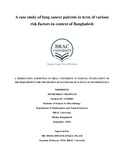| dc.contributor.advisor | Islam, Mohammad Rafiqul | |
| dc.contributor.author | Shabnam, Musharrat | |
| dc.date.accessioned | 2018-10-18T05:48:41Z | |
| dc.date.available | 2018-10-18T05:48:41Z | |
| dc.date.copyright | 2018 | |
| dc.date.issued | 2018-09 | |
| dc.identifier.other | ID 13326003 | |
| dc.identifier.uri | http://hdl.handle.net/10361/10726 | |
| dc.description | This thesis is submitted in partial fulfilment of the requirements for the degree of Bachelor of Science in Microbiology, 2018. | en_US |
| dc.description | Catalogued from PDF version of thesis report. | |
| dc.description | Includes bibliographical references (page 62-65) | |
| dc.description.abstract | Lung cancer is the most common cancer among men and women of Bangladesh. People who smoke for more than 10 years, expose to dusty environment, affect by infectious disease like tuberculosis, pneumonia and chronic obstructive pulmonary disease (COPD) are mostly affected by lung cancer. In Bangladesh lung cancer is an important health problem between the age of 50 and 70 with vital signs and symptoms. The present study aim is to provide awareness on the environmental risk factors related to smoking habit which causes lung cancer in Bangladesh. This study was carried out in the Department of Oncology at Ahsania Mission Cancer Hospital, Dhaka. This was a retrospective observational study.
This study was carried out during the period from November 2017 to May 2018 for 7 months of enrollment with a follow up of 3 months up to August 2018 which makes total study period of 10 months. Patients’ data were collected from the indoor and outdoor medical records of the AMCH hospital. A representative sample of 300 Bangladeshi cancer Patients aged over 30 was asked about their perception and the level of concern about various environmental lifestyle and genetic risk factor in relation to cancer prevention, as a part of a successful survey.
The patients suffering from adenocarcinoma (42%) is large in number and squamous cell carcinoma (30%) whereas small-cell carcinoma (15%) and carcinoid tumor (3%). Among 28 risk factors, the attributable fraction of lung cancer causing by tobacco smoking (67.3%) and environmental exposure were considered major risk factors. Some infectious diseases like Tuberculosis (39%) and Asthma (18%) were also considered as important risk factors. Patients more than 50 years of age were more likely to have lung cancer. For most risk factors, attributable fraction responses were higher in men (63%) than in women (37%). On the other hand, the attributable fractions of cancer by occupational exposure were considered low compared with other risk factors.
Our result suggests that awareness of the attributable fraction of lung cancer causes in the Bangladeshi cancer patients tends to be dominated by cancer causing infection, men and women hygiene tobacco smoking, chewing tobacco, occupational exposure and life style. In Bangladesh, it appears that most people are aware of the major risk factors of lung cancer. Hence there is need to promote awareness of lung cancer symptoms and develop and evaluate rapid assessment clinics for patients with suspected lung cancers. | en_US |
| dc.description.statementofresponsibility | Musharrat Shabnam | |
| dc.format.extent | 65 pages | |
| dc.language.iso | en | en_US |
| dc.publisher | BRAC University | en_US |
| dc.rights | BRAC University theses are protected by copyright. They may be viewed from this source for any purpose, but reproduction or distribution in any format is prohibited without written permission. | |
| dc.subject | Lung cancer | en_US |
| dc.subject | Chronic obstructive pulmonary disease | en_US |
| dc.subject | Ahsania Mission Cancer Hospital | en_US |
| dc.subject.lcsh | Lungs - Cancer | |
| dc.subject.lcsh | HEALTH & FITNESS - Diseases - Cancer | |
| dc.subject.lcsh | MEDICAL - Oncology. | |
| dc.title | A case study of lung cancer patients in term of various risk factors in context of Bangladesh | en_US |
| dc.type | Thesis | en_US |
| dc.contributor.department | Department of Mathematics and Natural Sciences, BRAC University | |
| dc.description.degree | B. Microbiology | |

